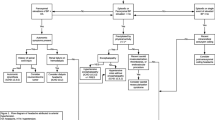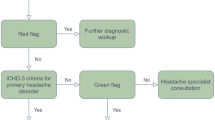Abstract
Purpose of Review
This review is intended to examine how the diagnostic criteria for migraine have evolved over the past 45 years and to evaluate the strengths and weaknesses of the current diagnostic criteria promulgated by the International Classification of Headache Disorders (ICHD).
Recent Findings
The ICHD is a comprehensive and systematic classification system for headache disorders. As the pathophysiology of migraine is more fully elucidated and more sophisticated diagnostic technologies are developed (e.g., the identification of biomarkers), the current diagnostic criteria for migraine will likely be further refined. The ICHD has allowed for more precise research study design in the field of headache medicine.
Summary
The current diagnostic criteria for migraine outlined in the 3rd version of the ICHD are far more sensitive and specific than the clinical criteria proposed in 1962. In future iterations, dividing episodic and chronic migraine into subtypes based on frequency (i.e., low frequency vs high frequency; near-daily vs daily) potentially could assist in guiding clinical management. In addition, a better understanding of aura, vestibular migraine, migrainous infarction, and hemiplegic migraine likely will lead to more refined diagnostic criteria for those entities.
Similar content being viewed by others
References
Papers of particular interest, published recently, have been highlighted as: • Of importance •• Of major importance
Ad hoc Committee on Classification of Headache of the National Institute of Health. Classification of headache. JAMA. 1962;179:717–8.
Göbel H. Classification of headaches. Cephalalgia. 2001;21(7):770–3. https://doi.org/10.1177/033310240102100707.
Headache Classification Committee of the International Headache Society. Classification and diagnostic criteria for headache disorders, cranial neuralgias, and facial pain. Cephalalgia. 1988;8(suppl 7):1–96.
•• The International Classification of Headache Disorders. Cephalalgia. 2018;38:1–211 The “Bible” of headache medicine outlining diagnostic criteria for headache disorders.
Rothrock J, Mar K, Yaksh T, Golbeck A, Moore A. Cerebrospinal fluid analyses in migraine patients and controls. Cephalalgia. 1995;15:489–93.
Ren C, Liu J, Zhou J, Liang H, Wang Y, Sun Y, et al. Lipidomic analysis of serum samples from migraine patients. Lipids in Health and Disease. 2018;17:22; Published online 2018 Feb 2. https://doi.org/10.1186/s12944-018-0665-0.
Kalita J, Uniyal R, Misra LK, Bhoi SK. Neuronal dysexcitability may be a biomarker of migraine: a visual evoked potential study. Clin EEG Neurosci. 2017. https://doi.org/10.1177/1550059417734106.
• Goadsby PJ, Edvinsson L, Ekman R. Vasoactive peptide release in the extracerebral circulation of humans during migraine headache. Ann Neurol. 1990;28:183–7 A landmark study reporting the substantial elevation of CGRP levels in external jugular venous blood of migraine patients.
Goadsby PJ, Edvinsson L. The trigeminovascular system and migraine: studies characterizing cerebrovascular and neuropeptide changes seen in humans and cat. Ann Neurol. 1993;33:48–56.
Edvinsson L, Uddman R. Neurobiology in primary headaches. Brain Res Rev. 2005:48, 438–456.
Gallai V, Sarchielli P, Floridi A, et al. Vasoactive peptide levels in the plasma of young migraine patients with and without aura assessed both interictally and ictally. Cephalalgia. 1995;15:384–90.
Tvedskov JF, Lipka K, Ashina M, et al. No increase of calcitonin gene-related peptide in jugular blood during migraine. Ann Neurol. 2005;58:561–8.
Fusayasu E, Kowa H, Takeshima T, et al. Increased plasma substance P and CGRP levels, and high ACE activity in migraineurs during headache-free periods. Pain. 2007;28:209–14.
Ashina M, Bendtsen L, Jensen R, et al. Evidence of increase plasma levels of calcitonin gene-related peptide in migraine outside of attackes. Pain 200;86: 133–138.
Cady R, Gutterman D, Daiers J, Beach M. Responsiveness of non-IHS migraine and tension type headache to sumatriptan. Cephalalgia. 1997;5:588–90.
• Lipton R, Stewart W, Cady R, Hall C, et al. Sumatriptan for the range of headaches in migraine sufferers: results of the Spectrum Study. Headache. 2000;40:783–91 Randomized cross-over study demonstrating a sumatriptan-responsive mechanism for a variety of headache types experienced by migraineurs.
Rothrock JF, Kelly NM, Brody ML, Golbeck A. A differential response to treatment with divalproex sodium in patients with intractable headache. Cephalalgia. 1994;14:241–4.
Rothrock J, Patel M, Lyden P, Jackson C. Demographic and clinical characteristics of patients with episodic migraine versus chronic daily headache. Cephalalgia 1996.
Michael A, Michael D, Rothrock J. Predictors of early positive response to treatment of chronic migraine with on a botulinum toxin A. Headache 2016.
Author information
Authors and Affiliations
Corresponding author
Ethics declarations
Conflict of Interest
Amanda Tinsley reports that she is a speaker for Amgen’s Speaker Bureau for migraine disease state and CGRP antagonist. John Farr Rothrock declares no conflict of interest.
Human and Animal Rights and Informed Consent
This article does not contain any studies with human or animal subjects performed by any of the authors.
Additional information
This article is part of the Topical Collection on Migraine and Beyond
Rights and permissions
About this article
Cite this article
Tinsley, A., Rothrock, J.F. What Are We Missing in the Diagnostic Criteria for Migraine?. Curr Pain Headache Rep 22, 84 (2018). https://doi.org/10.1007/s11916-018-0733-1
Published:
DOI: https://doi.org/10.1007/s11916-018-0733-1




